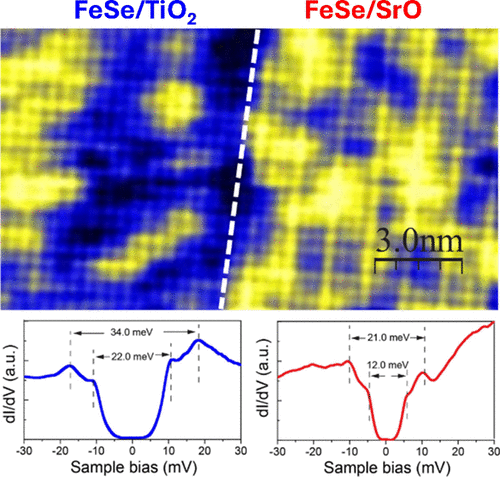通过衬底表面终端揭示单层FeSe的增强超导性
IF 9.1
1区 材料科学
Q1 CHEMISTRY, MULTIDISCIPLINARY
引用次数: 0
摘要
SrTiO3(001)衬底上单层FeSe的超导转变温度远高于块体FeSe,这主要归因于电子掺杂、界面电子-声子耦合和电子相关性等因素。为了找出主要的驱动因素,我们在SrTiO3(001)衬底上生长了单层FeSe薄膜,其中TiO2和SrO表面末端共存。扫描隧道光谱显示tio2端超导隙(17.0 meV)大于sro端超导隙(10.5 meV)。隧道光谱在SrO表面也显示出更大的功函数,导致向FeSe转移的电荷减少,这一点得到了角分辨光电发射光谱的证实。扫描透射电子显微镜进一步显示出不同的界面原子尺度结构,Se-Fe-Se四面体角从sro端109.5°变化到tio2端104.9°。与动态平均场理论计算相比,我们的结果表明,单层FeSe/TiO2的超导性增强来自于最佳的电子相关性,以及衬底的充分电荷转移。本文章由计算机程序翻译,如有差异,请以英文原文为准。

Unraveling Enhanced Superconductivity in Single-Layer FeSe through Substrate Surface Terminations
Single-layer FeSe on SrTiO3(001) substrates shows a superconducting transition temperature much higher than that of bulk FeSe, which has been attributed to factors such as electron doping, interfacial electron–phonon coupling, and electron correlations. To pinpoint the primary driver, we grew single-layer FeSe films on SrTiO3(001) substrates with coexisting TiO2 and SrO surface terminations. Scanning tunneling spectroscopy revealed a larger superconducting gap (17.0 meV) on the TiO2-termination than on the SrO-termination (10.5 meV). Tunneling spectroscopy also showed a larger work function on the SrO surface, resulting in reduced charge transfer to FeSe, as confirmed by angle-resolved photoemission spectroscopy. Scanning transmission electron microscopy further revealed distinctive interfacial atomic-scale structures, with the Se–Fe–Se tetrahedral angle changing from 109.5° on the SrO-termination to 104.9° on the TiO2-termination. Compared to dynamical mean field theory calculations, our results indicate that enhanced superconductivity in single-layer FeSe/TiO2 arises from optimal electron correlations, in addition to sufficient charge transfer from the substrate.
求助全文
通过发布文献求助,成功后即可免费获取论文全文。
去求助
来源期刊

Nano Letters
工程技术-材料科学:综合
CiteScore
16.80
自引率
2.80%
发文量
1182
审稿时长
1.4 months
期刊介绍:
Nano Letters serves as a dynamic platform for promptly disseminating original results in fundamental, applied, and emerging research across all facets of nanoscience and nanotechnology. A pivotal criterion for inclusion within Nano Letters is the convergence of at least two different areas or disciplines, ensuring a rich interdisciplinary scope. The journal is dedicated to fostering exploration in diverse areas, including:
- Experimental and theoretical findings on physical, chemical, and biological phenomena at the nanoscale
- Synthesis, characterization, and processing of organic, inorganic, polymer, and hybrid nanomaterials through physical, chemical, and biological methodologies
- Modeling and simulation of synthetic, assembly, and interaction processes
- Realization of integrated nanostructures and nano-engineered devices exhibiting advanced performance
- Applications of nanoscale materials in living and environmental systems
Nano Letters is committed to advancing and showcasing groundbreaking research that intersects various domains, fostering innovation and collaboration in the ever-evolving field of nanoscience and nanotechnology.
 求助内容:
求助内容: 应助结果提醒方式:
应助结果提醒方式:


